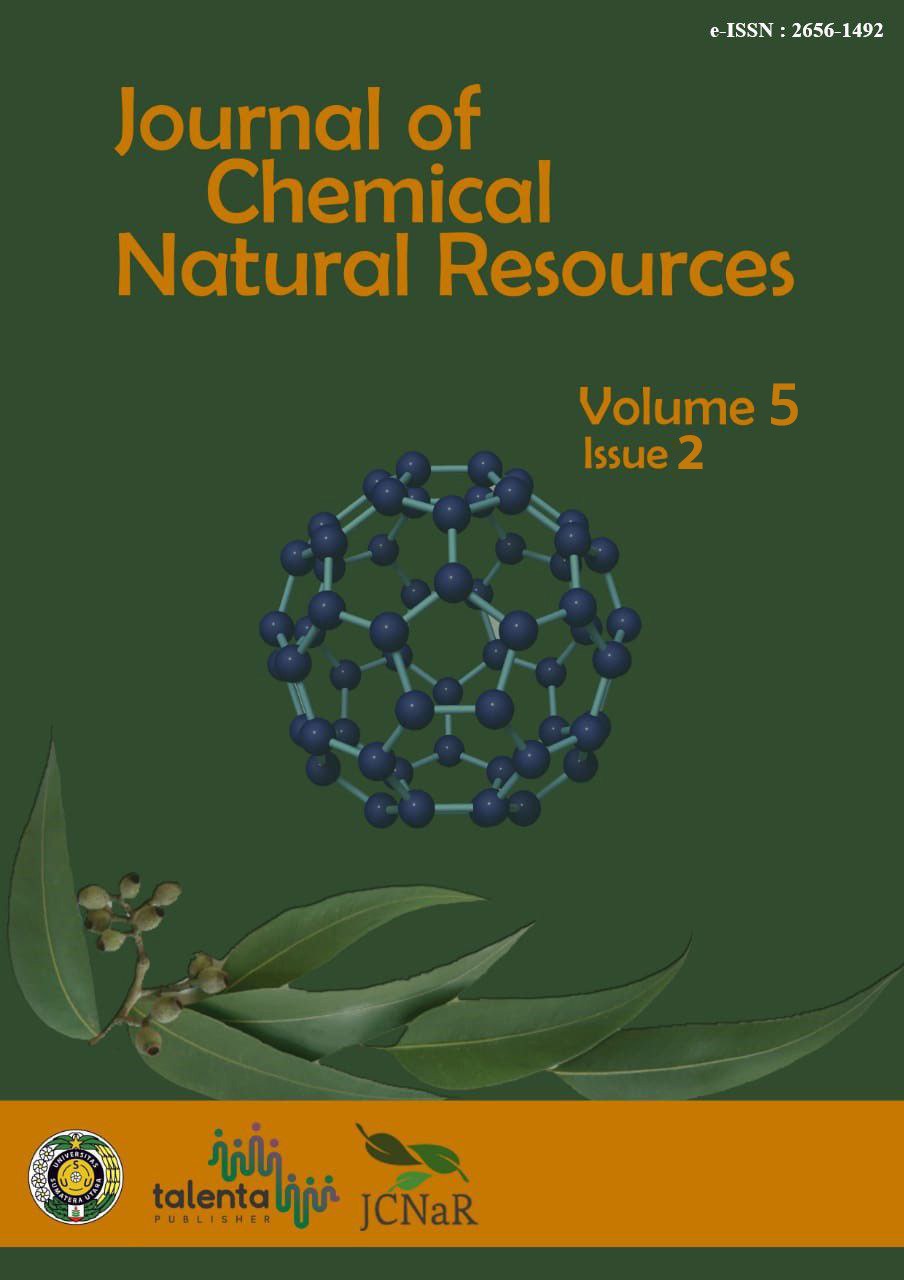Synthesis of Cardanil Methyl Ether via Etherification Reaction Cardanol Isolated from Cashew Nut Shells (Anacardium occidentale L.) with Variations of Molar Methyl Iodide
DOI:
https://doi.org/10.32734/jcnar.v5i2.13837Keywords:
Cardanol, Cardanyl Methyl Eter, Etherification, Methyl IodideAbstract
The synthesis of the Cardanyl methyl ether is carried out through an etherization reaction between Cardanyl seed skin extract (CNSL) isolated from the methyl iodide. Cardanol is isolated with the addition of acetone, Ca(OH)2, NH4OH 25%, n-hexane: ethyl acetate (98:2), washing with NaOH 2.5%, HCl 5%, aquadest, and Na2SO4 anhydrate. The yield of the obtained cardanol is 74.39 g (74.39% of the initial weight of the CNSL) and has the following characteristics: acid count 1.2863 mgKOH/g, iodine count 215.6535 g I2/100 g, viscosity 38.7 cP, density 0.8266 g/mL, pH = 6.14. The FT-IR methyl ether Cardanyl spectrum shows an absorption band at 1162.9-1259.8 cm-1 shows a C-O stretching group at a wave number of 1043.6-1148.0 cm-1 showing the formation of an asymmetric and symmetrical C- O-C stretching band of the ether compound, the Spectra of the FT - IR methyl ether Cardanyl shows an absorptive band at 1162-1259-125,8 cm-1, showing a C-O stretching Group, at the wave number of 1043.6-1148.0 cm-1 indicating the formation, as a result, of an Asymmetric and Symmetric Stretching Group of the ethereal Compound. The Cardanyl methyl ether was synthesized by adding K2CO3, the solvent acetone and the iodide-methyl, with a reflux time of 8 hours. As for the parameters carried out in this study, the molar variation of the Cardanyl is the Methyl Iodide (1:1.5, 1:3, and 1:4.5) and yields 3.555 g; 12.084 g; 11.472 g of Cardanyl ether. Methyl ether Cardanyl was obtained in analysis with FT-IR and GC-MS spectroscopic photometers. The results of the analysis of Cardanyl methyl ethers with GC -MS were 63.28%, and the results of analysis of the Cardanyl ether with a variation of the molar ratio Cardanyl: Methyl iodide (1:1.5; 1:3; 1:4.5) with GC-MS obtaining 3.05%, 30.29%, and 26.58%. These results show the maximum percentage of methyl ethers Cardanyl at the reaction conditions of the variation molar ratios Cardanyl iodides (1:3), K2CO3 17.3 g, 50 mL of acetone, and 8 hours of reflux time.
Downloads
References
J. Towaha and N. Ahmadi, “Pemanfaatan Cashew Nut Shell Liquid Sebagai Sumber Fenol Alami Pada Industri,†Bul. RISTRI, vol. 2, no. 2, pp. 187–198, 2011.
F. H. . Rodrigues, F. C. . Franca, J. R. . Souza, N. M. P. . Ricardo, and J. P. . Feitosa, “Comparison Between Physico-Chemical Properties of the Technical Cashew Nut Shell Liquid (CNSL) and those Natural Extracted from Solvent and Pressing,†Polimeros, vol. 21, pp. 156–160, 2011.
T. S. Gandhi, B. Z. Dholakiya, and M. R. Patel, “Extraction protocol for isolation of CNSL by using protic and aprotic solvents from cashew nut and study of their physico-chemical parameter,†Polish J. Chem. Technol., vol. 15, no. 4, pp. 24–27, 2013, doi: 10.2478/pjct-2013-0062.
C. E. Dhurhania and A. Novianto, “Uji Kandungan Fenolik Total dan Pengaruhnya terhadap Aktivitas Antioksidan dari Berbagai Bentuk Sediaan Sarang Semut (Myrmecodia pendens),†J. Farm. Dan Ilmu Kefarmasian Indones., vol. 5, no. 2, p. 62, 2019, doi: 10.20473/jfiki.v5i22018.62-68.
N. N. F. Hanin and R. Pratiwi, “Kandungan Fenolik, Flavonoid dan Aktivitas Antioksidan Ekstrak Daun Paku Laut (Acrostichum aureum L.) Fertil dan Steril di Kawasan Mangrove Kulon Progo, Yogyakarta,†J. Trop. Biodivers. Biotechnol., vol. 2, no. 2, p. 51, 2017, doi: 10.22146/jtbb.29819.
M. C. Lubi and E. T. Thachil, “Cashew nut shell liquid (CNSL) - A versatile monomer for polymer synthesis,†Des. Monomers Polym., vol. 3, no. 2, pp. 123–153, 2000, doi: 10.1163/156855500300142834.
W. S. J. Li, F. Cuminet, V. Ladmiral, P. Lacroix-Desmazes, S. Caillol, and C. Negrell, “Phosphonated and methacrylated biobased cardanol monomer: Synthesis, characterization and application,†Prog. Org. Coatings, vol. 153, 2021, doi: 10.1016/j.porgcoat.2020.106093.
S. Jing, T. Li, X. Li, Q. Xu, J. Hu, and R. Li, “Phenolic foams modified by cardanol through bisphenol modification,†J. Appl. Polym. Sci., vol. 131, no. 4, pp. 1–7, 2014, doi: 10.1002/app.39942.
Y. Hu et al., “Use of cardanol-based acrylate as reactive diluent in UV-curable castor oil-based polyurethane acrylate resins,†Ind. Crops Prod., vol. 117, no. February, pp. 295–302, 2018, doi: 10.1016/j.indcrop.2018.02.053.
Y. Hannoda, Y. Akasaka, and M. Shibata, “Bio-based thermosetting bismaleimide resins using cardany linolenate and allyl cardanyl ether,†React. Funct. Polym., vol. 97, pp. 96–104, 2015, doi: 10.1016/j.reactfunctpolym.2015.10.014.
P. Jia, L. Hu, Q. Shang, R. Wang, M. Zhang, and Y. Zhou, “Self-Plasticization of PVC Materials via Chemical Modification of Mannich Base of Cardanol Butyl Ether,†ACS Sustain. Chem. Eng., vol. 5, no. 8, pp. 6665–6673, 2017, doi: 10.1021/acssuschemeng.7b00900.
F. . Njuku, “Evaluation of Cashew Nut Shell Liquid Based Products as Reactive Diluents for Alkyd Coatings,†Jomo Kenyatta University, 2015.
R. Paramashivappa, P. Phani Kumar, P. J. Vithayathil, and A. Srinivasa Rao, “Novel method for isolation of major phenolic constituents from cashew (Anacardium occidentale L.) Nut shell liquid,†J. Agric. Food Chem., vol. 49, no. 5, pp. 2548–2551, 2001, doi: 10.1021/jf001222j.
Risfaheri and S. Kailaku, “Teknologi Pengembangan Produk Turunan Minyak Kulit Biji Di dalam : Pengembangan Industri Berbasis Pertanian.,†Balai Besar Penelit. dan Pengemb. Pascapanen Pertan., pp. 709–722, 2005.
Y. Teramoto, “Functional thermoplastic materials from derivatives of cellulose and related structural polysaccharides,†Molecules, vol. 20, no. 4, pp. 5487–5527, 2015, doi: 10.3390/molecules20045487.

Downloads
Published
Issue
Section
License
Copyright (c) 2023 Journal of Chemical Natural Resources

This work is licensed under a Creative Commons Attribution-ShareAlike 4.0 International License.














